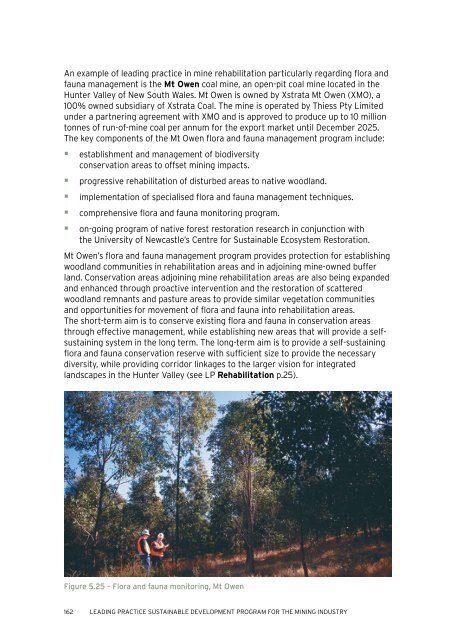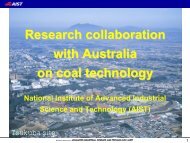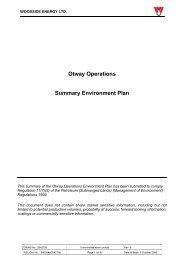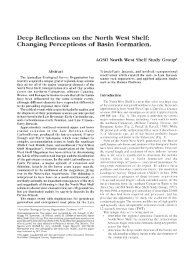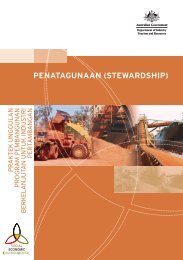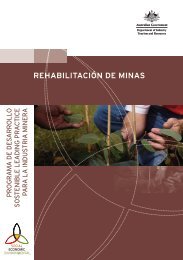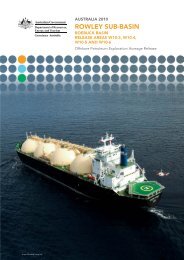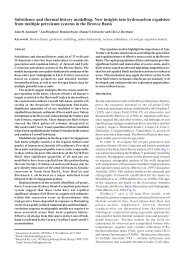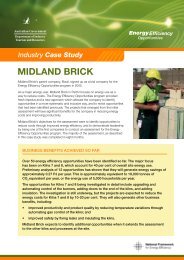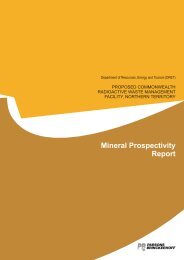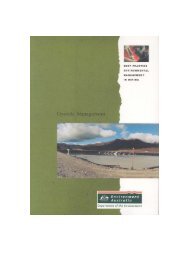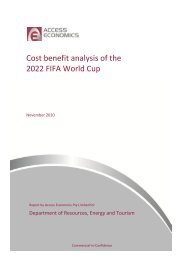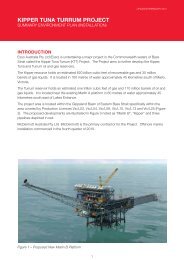A guide to leading practice sustainable development in mining
A guide to leading practice sustainable development in mining
A guide to leading practice sustainable development in mining
You also want an ePaper? Increase the reach of your titles
YUMPU automatically turns print PDFs into web optimized ePapers that Google loves.
An example of <strong>lead<strong>in</strong>g</strong> <strong>practice</strong> <strong>in</strong> m<strong>in</strong>e rehabilitation particularly regard<strong>in</strong>g flora and<br />
fauna management is the Mt Owen coal m<strong>in</strong>e, an open-pit coal m<strong>in</strong>e located <strong>in</strong> the<br />
Hunter Valley of New South Wales. Mt Owen is owned by Xstrata Mt Owen (XMO), a<br />
100% owned subsidiary of Xstrata Coal. The m<strong>in</strong>e is operated by Thiess Pty Limited<br />
under a partner<strong>in</strong>g agreement with XMO and is approved <strong>to</strong> produce up <strong>to</strong> 10 million<br />
<strong>to</strong>nnes of run-of-m<strong>in</strong>e coal per annum for the export market until December 2025.<br />
The key components of the Mt Owen flora and fauna management program <strong>in</strong>clude:<br />
establishment and management of biodiversity<br />
conservation areas <strong>to</strong> offset m<strong>in</strong><strong>in</strong>g impacts.<br />
progressive rehabilitation of disturbed areas <strong>to</strong> native woodland.<br />
implementation of specialised flora and fauna management techniques.<br />
comprehensive flora and fauna moni<strong>to</strong>r<strong>in</strong>g program.<br />
on-go<strong>in</strong>g program of native forest res<strong>to</strong>ration research <strong>in</strong> conjunction with<br />
the University of Newcastle’s Centre for Susta<strong>in</strong>able Ecosystem Res<strong>to</strong>ration.<br />
Mt Owen’s flora and fauna management program provides protection for establish<strong>in</strong>g<br />
woodland communities <strong>in</strong> rehabilitation areas and <strong>in</strong> adjo<strong>in</strong><strong>in</strong>g m<strong>in</strong>e-owned buffer<br />
land. Conservation areas adjo<strong>in</strong><strong>in</strong>g m<strong>in</strong>e rehabilitation areas are also be<strong>in</strong>g expanded<br />
and enhanced through proactive <strong>in</strong>tervention and the res<strong>to</strong>ration of scattered<br />
woodland remnants and pasture areas <strong>to</strong> provide similar vegetation communities<br />
and opportunities for movement of flora and fauna <strong>in</strong><strong>to</strong> rehabilitation areas.<br />
The short-term aim is <strong>to</strong> conserve exist<strong>in</strong>g flora and fauna <strong>in</strong> conservation areas<br />
through effective management, while establish<strong>in</strong>g new areas that will provide a selfsusta<strong>in</strong><strong>in</strong>g<br />
system <strong>in</strong> the long term. The long-term aim is <strong>to</strong> provide a self-susta<strong>in</strong><strong>in</strong>g<br />
flora and fauna conservation reserve with sufficient size <strong>to</strong> provide the necessary<br />
diversity, while provid<strong>in</strong>g corridor l<strong>in</strong>kages <strong>to</strong> the larger vision for <strong>in</strong>tegrated<br />
landscapes <strong>in</strong> the Hunter Valley (see LP Rehabilitation p.25).<br />
Figure 5.25 – Flora and fauna moni<strong>to</strong>r<strong>in</strong>g, Mt Owen<br />
162 LEADING PRACTICE SUSTAINABLE DEVELOPMENT PROGRAM FOR THE MINING INDUSTRY


